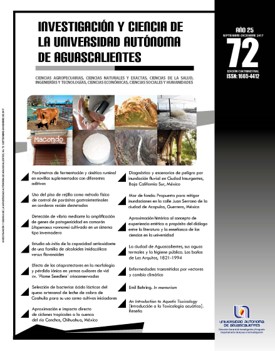Tropical cyclones approach and direct impact on the Conchos river basin in Chihuahua, Mexico
DOI:
https://doi.org/10.33064/iycuaa201772222Keywords:
tropical cyclone, direct hit, approximation, precipitation, trendAbstract
Tropical cyclones provide precipitation in continental regions. These natural events can bring rainfall due to the direct impact or close approximation to inland regions (without coast) of Mexico. In recent years, the total precipitation in arid and semi-arid regions of Mexico has been modified due to the increase in the number of hurricanes originated in the Atlantic and Pacific oceans. For the period of analysis (1949 to 2013), this study estimated the share of the total number of tropical cyclones that impacted Mexico's coast from the Atlantic and Pacific Ocean, 6.28% and 8.64, respectively. For the same period, only 10 tropical cyclones directly impacted the Conchos river basin and 142 had a close trajectory to the Conchos river basin (less than 550 kilometers). In summary, there is an increase in the frequency of tropical cyclones generated in the Pacific Ocean.
Downloads
References
Blake, E. S., Gibney, E. J., Brown, D. P., Mainelli, M., Franklin, J. L., & Kimberlain, T. B. (2009). Tropical Cyclones of the Eastern North Pacific Basin, 1949-2006. Asheville, NC: National Climatic Data Center-National Hurricane Center.
Díaz Castro, S. C. (2010). Variabilidad de los ciclones tropicales que afectan a México. Interciencia, 35(4), 306-310.
Englehart, P. J., & Douglas, A. V. (2001). The role of Eastern North Pacific tropical storms in the rainfall climatology of Western Mexico. International Journal of Climatology, 21(11), 1357-1370. doi:10.1002/joc.637
Holland, G. J. (1993). Ready Reckoner. En Global Guide to Tropical Cyclone Forecasting (Chapter 9). WMO/TC-No. 560. Report TCP-31. Geneva: World Meteorological Organization.
Jáuregui, E. (2003). Climatology of landfalling hurricanes and tropical storms in Mexico. Atmósfera, 16(4), 193-204.
Kelly, M. E. (2001). El río Conchos: Un informe preliminar. Austin, TX: Texas Center for Policy Studies.
Méndez González, J., Návar Cháidez, J. de J., & González Ontiveros, V. (2008). Análisis de tendencias de precipitación (1920-2004) en México. Investigaciones geográficas, Boletín del Instituto de Geografía, UNAM, 65, 38-55.
National Hurricane Center. (2016). NHC Data Archive, Best Track Data (HURDAT2) [Base de datos]. Recuperado de http://www.nhc.noaa.gov/data/?text
Rakhecha, P. R., & Singh, V. P. (2009). Applied Hydrometeorology. New Dehli: Springer.
Rosengaus Moshinsky, M. (2010). Impacto de los ciclones tropicales en las cuencas de México. En H. Cotler Ávalos (Coord.), Las cuencas hidrográficas de México (pp. 32-37). México: Secretaría de Medio Ambiente y Recursos Naturales-Instituto Nacional de Ecología-Fundación Gonzalo Río Arronte.
Rosengaus Moshinsky, M., Jiménez Espinosa, M., & Vázquez Conde, M. T. (2002). Atlas climatológico de ciclones tropicales en México (Centro Nac) (106 pp.). Distrito Federal, México: CENAPRED. Recuperado de http://www.cenapred.gob.mx/es/Publicaciones/archivos/37.pdf
Secretaría del Medio Ambiente y Recursos Naturales. (2013). Informe de la Situación del Medio Ambiente en México. Compendio de Estadísticas Ambientales. Indicadores Clave y de Desempeño Ambiental. Edición 2012. México: Autor.
Servicio Meteorológico Nacional. (2017). Datos climáticos diarios del CLICOM del SMN a través de su plataforma web del CICESE [Base de datos]. Recuperado de http://clicom-mex.cicese.mx
Downloads
Published
How to Cite
License
Las obras publicadas en versión electrónica de la revista están bajo la licencia Creative Commons Atribución-NoComercial-CompartirIgual 4.0 Internacional (CC BY-NC-SA 4.0)









